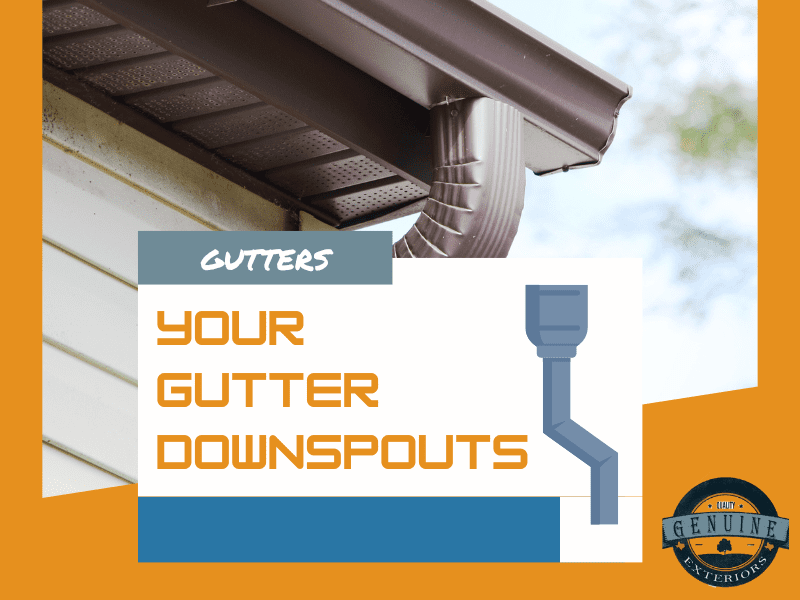Are you looking for gutter downspout information?
Your home’s gutter system plays an essential role to your home’s foundation, helping run-off water from your roof get to the correct location; however, as overshadowed as they can be, your home wouldn’t be the same without your downspouts!
Chances are you’ve seen them but couldn’t recognize them. After today, you’ll be able to do both. We’ll educate you about them along with some tips and tricks to make sure they stay in working order at all times!
What are Gutters and Downspouts for?

Gutters serve as a system for rainwater drainage, removing excess water and also other debris from your roof. Gutter downspouts, apart of the gutter system, help divert water from the roofline to away from the home’s foundation to a drain or ground level.
For every 40 feet of gutters, there should be at least one downspout properly installed. That way, water can be adequately displaced. To help you remember, gutters collect the water, and downspouts displace the water away from your home!
Are gutter downspouts necessary?
Rain gutter downspouts are absolutely necessary because it helps protect your roof, siding, and home’s foundation from water damage that can undermine your roof let alone structural integrity as it effectively drains excess water. Also it helps prevent soil erosion and prevents basement leaks by not allowing water to just pool in one area on the ground. An essential role!
Aluminum vs. Vinyl Gutters and downspouts

There are two main types of gutters and downspouts found in the marketplace;
- Aluminum (your best choice)
- Vinyl (your cheapest choice in price and in quality)
Here’s a comparison breakdown when it comes to installation, performance, and cost:
Installation
Vinyl gutters are relatively easy to install and come in seam varieties (not all in one piece, multiple pieces joined together), making them doable for a DIY if that suits your fancy. On the other hand, aluminum gutters typically come in seamless varieties which is best suited for professional expertise to install.
Performance
Due to their weight and composition, vinyl gutters and downspouts do not perform well in chronic inclement weather and can break easily if enough force is applied over time. Seam varieties are more vulnerable due to their need be joined with other sections. However, aluminum, although it can rust, can withstand harsh weather due its metallic durability and seamless attribute.
Cost
Vinyl gutter and downspouts are much more cost-effective than their aluminum counterparts in the initial upfront cost; however, factoring in maintenance and durability over time, aluminum makes a more inexpensive choice. What’s right for your situation trumps cost of said materials.
Aluminum gutters are still super affordable, and you can use our online gutter calculator tool here to estimate how much they cost for free!
Want to get an instant Gutter Price?
Use the Genuine Exterior “Gutter Calculator” here, and you will get an instant price for new seamless aluminum gutters! We can give you an instant quote for all 5″ and 6″ gutters.
How far away from the house should the gutters drain?
It is considered best practice to have your gutter downspout drain four feet more or less from your home to reduce the risk of pooling water; however, keep in mind three critical variables that may alter the appropriate distance:
- Local building codes
- Variety of Soil
- The slope of your home
Downspout Extension (Downspout diverter)
Downspout extensions are gutter accessories that give you the convenience in controlling the direction of rain flow from your gutter to where it needs to go (rain barrel, drain, etc.) and certainly helps in the three special cases above.
A good, flexible downspout extension protects against water overflow, mitigates the risk of downspout clogs, and actually helps protect against mosquitos due to its enclosed nature. Talk about a win for convenience!
Downspout Questions:
Where do downspouts drain into?

Downspouts have several places where they can drain and are often separated into above-ground and below-ground drainage. The former can be the use of a rain barrel and any manner where the water is visible, collected, and stored. At the same time, the latter often is an interconnected chain of pipes underground, transferring it from one place to another.
Other options include using a rain chain in addition to a rain barrel to help collect and disperse rainwater. Similar to a downspout diverter, a rain chain diverts water from the point of the gutter trough.
The upside to using downspout extensions and downspout diverters is you can water your lawn/landscaping with your rainwater. You can read more about drainage solutions here.
Where can I see professional help for my gutter downspouts?
Finding professional help is as easy as a quick search online. It is highly recommended that you stay local as your context will be better understood that way, and compare and contrast prices to ensure you get the best deal!
While some gutter materials can be a DIY job like vinyl, seeking professional help and guidance with your gutter system is recommended due to the inherent risk of injury. Your gutter downspouts are seldom a DIY job. You can see what professional gutter installation photos look like here!
What’s the Verdict?
Downspouts are not flashy, but they do play a huge role in proper rainwater displacement! They come in different materials and are connected to an end source by an extension/diverter to ensure your home is not affected negatively by pooling water. Pretty nifty, right?
If you have any questions in regard to your downspouts and need professional assistance, we are more than welcome to come and assess the context of your situation. We’re just one call away!


 Gutter Warranty Info: Do New Gutters Come With a Warranty?
Gutter Warranty Info: Do New Gutters Come With a Warranty?